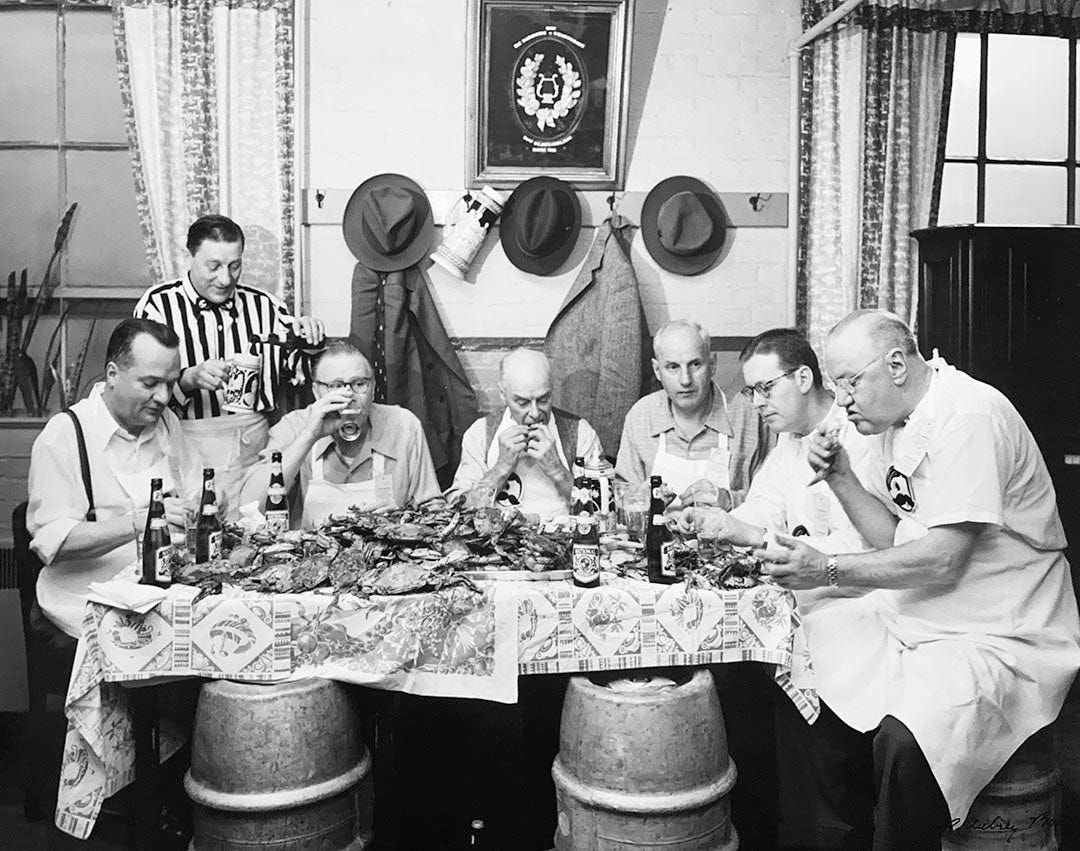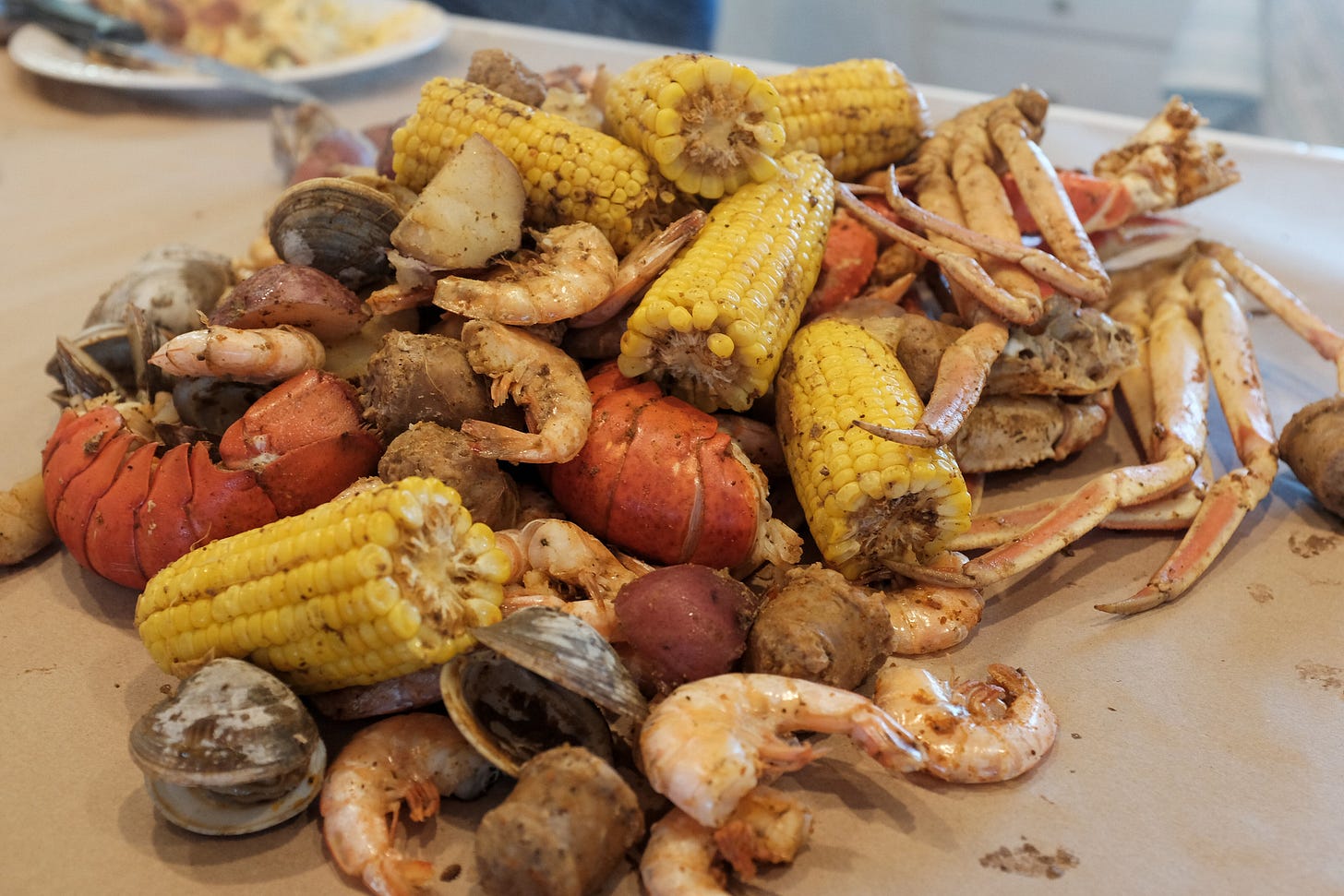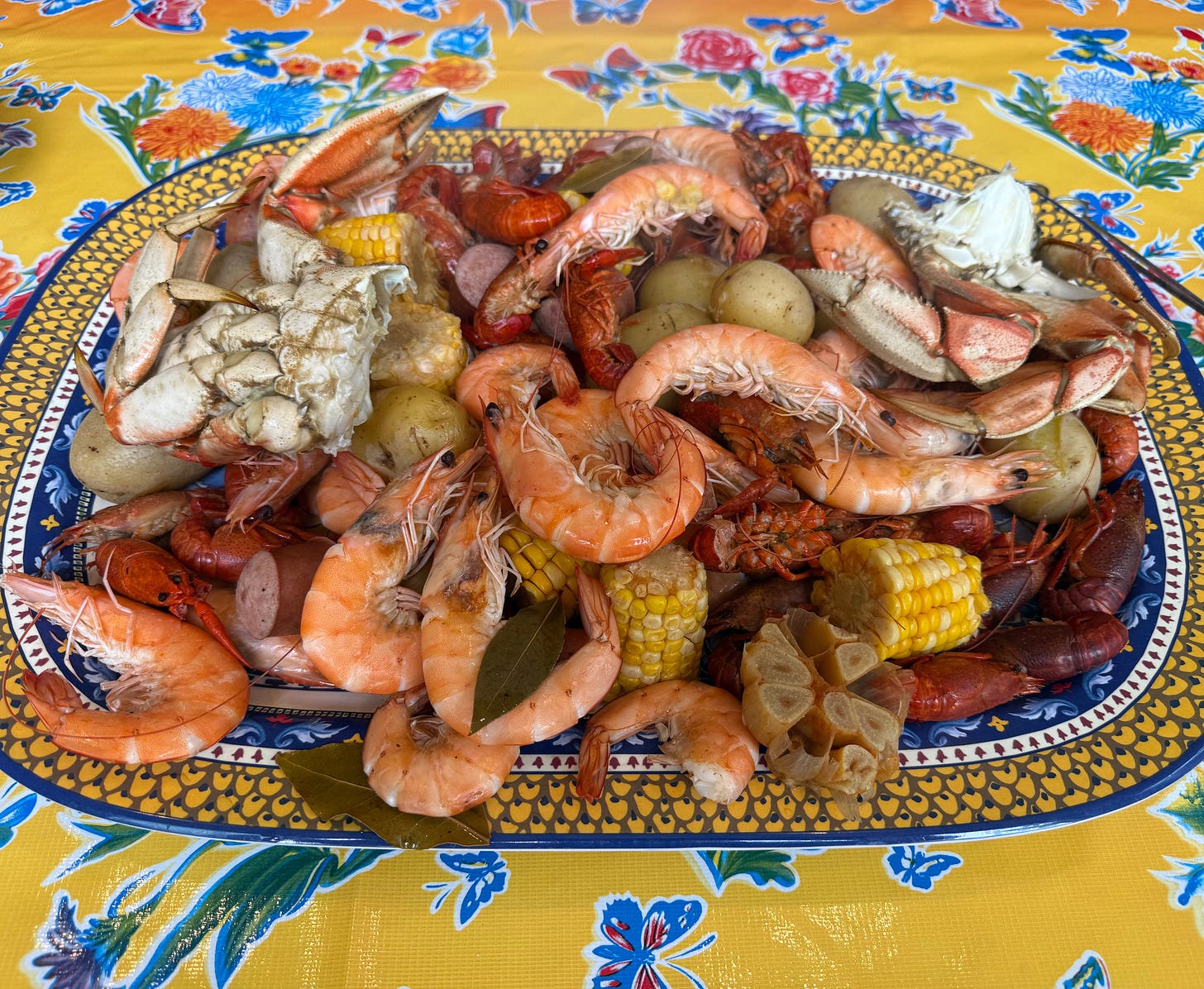The Great American Seafood Boil
I would argue that the great American meal just might be the magnificent tradition of the Summertime Seafood Feast.
People think of hamburgers and hot dogs, or perhaps apple pie or pizza, as the most traditional American foods. There are arguments to be made for all of these foods and more, of course. But I believe there is one food tradition that has been overlooked as an icon of American cuisine: the seafood boil.
For one thing, Native Americans didn’t go around eating hamburgers. Indigenous Americans, especially those from coastal areas, relied on seafoods for most of their animal protein. Shellfish were an especially important food source- we know this because shell middens, great prehistoric piles of discarded crustacean shells, are found along all three American coasts. Some of these shellfish were eaten raw, and some were roasted over the fire, but some were cooked using water or steam: the prehistoric ancestor to the modern American tradition of seafood boils.
Today, along America’s Eastern and Southern seaboards, every regional culture has its own interpretation of the communal seafood feast. Based on local shellfish and cooked by steaming or boiling, the feasts are always reason for large numbers of people to get together and consume huge amounts of seafood. These feasts can be associated with civic events like town picnics, or they might be backyard party-time food. They are often consumed near the beach with bare feet and lots of beer. They are eaten messily, bare hands breaking shells and slurping broth, crab juice or shrimp brine running down the chin in an orgy of shellfish and steam. Special bibs and plastic tablecloths are manufactured for these feasts, since the crayfish or lobsters are often spilled out on the table, without a plate in sight (sometimes newspapers are used to soak up the mess). If you haven’t had a seafood boil, you’ve missed something glorious: a primitive, joyous, fun, sensational feast for the senses. These seafood boils vary in form and flavor, depending on the region where they’re eaten. But they mainly fall into four categories, with one interesting extra. But I’ll get to that. Starting from the north, a guide to the four great seafood feasts of the United States!
The New England Clambake: In coastal New England, from Maine to Connecticut, you’ll find a thing called a clambake. The name is misleading- nothing is baked in the modern sense of the word. The name comes from what is called a “pit oven”, a small, temporary pit dug in a sandy beach and lined with smooth beach stones. Inside this pit, a fire is built, heating the stones until they are sizzling hot. The spent fire is scraped away, and the pit is filled with wet seaweed, clams, lobster, shrimp, corn, and potatoes. Sometimes, sausage- especially “Portuguese sausage” is added. More seaweed covers the pit, along with a layer of burlap and some seawater, which turns into steam to cook the shellfish. A few bottles of beer later, the pit is opened and the food removed, served to the diners with huge amounts of melted butter and lemons. This can be called a lobster bake, especially in Maine, but it’s basically the same thing. The shellfish are actually cooked by the boiling seawater, which turns into steam with the scent of the sea. One can also boil a clambake in a giant pot, but steam is favored, and seaweed and seawater in the pot are highly recommended.
There are two theories for the origin of the clambake. One claims it is a direct inheritance of Native foodways, especially from the Wampanoag nation’s appanaug, a seafood feast. Another school has it that the clambake is a 18th century invention, created as a colonial simulation and tribute to Native American cuisine. Either way, the clambake is a deep part of New England tradition, and you’ll find them all over, especially during the summer months.
The Crab Feast of the Chesapeake: Farther South in the mid-Atlantic region, the great Chesapeake bay runs from Virginia to Maryland. The Chesapeake is the largest estuary in the United States and the third largest in the world, and is a famously productive body of water, historically producing huge amounts of oysters and crabs. The most famous species here is the Maryland Blue Crab, a medium-sized crab noted for its especially sweet meat. A crab feast in this region features blue crabs steamed over beer, served with corn on the cob. The crucial addition to the seafood feast here is Old Bay, a spice blend invented as a crab seasoning in 1939 by Gustav Brunn, a Jewish merchant who had fled the European holocaust. Old Bay- a secret blend of 18 herbs and spices- is now considered an essential accompaniment to seafood boils everywhere from Baltimore south. In the Chesapeake region, crabs are often coated in Old Bay before steaming, creating a spicy crust on the shell that mixes with the crab as it is picked from its shell. Or else they may be boiled in a broth seasoned with beer and Old Bay. Crab juice runs down your sleeves as you pick every bit of delicious meat from the crab’s legs, so eating outside is a must.
The Low Country Boil: From the Carolinas to Georgia, the Low Country Boil is king. From here south, seafood is boiled instead of steamed, in a richly flavored broth intended to season the seafood. The dish is also called Frogmore Stew, after a town in South Carolina, and is said to be influenced by the Gullah culture, a unique African-American coastal community and way of life. This is shrimp territory, and that shellfish takes center stage here. The boil broth is well-spiced, includes beer and lemons, and features corn, potatoes, and sausage along with the shrimp. Old Bay is a major part of the spice blend, however hotter spices begin to enter the picture here. Melted butter and cold beer are musts.
The Gulf Coast Seafood Boil: The next regional style- and perhaps the most famous- is the seafood boil of the Gulf Coast. Louisiana is the center of this tradition, and the state puts its own cultural spin on the familiar seafood feast. Like the Low Country Boil, the Gulf Coast boil cooks the seafood in a spicy broth, but here the spice level is ratcheted up significantly with the addition of cayenne pepper. The other major addition is crawfish: the freshwater crustacean that resembles a mini-lobster and is sometimes called a “mud bug”. This style might be called a “Cajun”, “Creole” or “Louisiana” seafood boil, and these are intense in every sense of the word: corn, potatoes, spicy andouille sausage, shrimp, crawfish, lobster, crab, lemons, onions, and garlic in an intensely spicy broth. The boil (pronounced “boll” in the Gulf Coast dialect) is a deep part of community culture, and they can be HUGE events serving hundreds of people. But the best boils are backyard affairs, with music and food and beer.
Restaurants serving this “Cajun” style seafood have become popular, which leads us to our next regional sub-style:
Bonus: The Asian Neighborhood Seafood Boil- In the wake of the Vietnam war, Vietnamese immigrants settled in two main places in the U.S.: Garden Grove, California, and Houston, Texas. In the early 1990s, Dada Ngo and Sinh Nguyen, two Vietnamese-American twenty somethings, met at a backyard seafood boil in the Gulf coast town of Seadrift, Texas. They fell in love twice that day: once with each other and also with Cajun-style boiled seafood. After relocating to Garden Grove, they decided to open The Boiling Crab, a restaurant specializing in the backyard-style Cajun seafood boil. The restaurant was a huge success, and became the best-known of a humongous wave of Cajun-style seafood boil restaurants opening in Asian neighborhoods, especially in Texas and California. Seafood boils appeal to the Asian-American fondness for seafood, for intense spice, and for family-style eating: you’ll find that the Boiling Crab and its competitors often have hours-long lines on weekends.
Master Recipe for the Great American Seafood Boil
Want to make your own backyard boil? Here’s how:
First, you have to get an enormous pot and find a way to heat it. You can do this on the indoor stove but your house will smell like shrimp for a week. I have a burner on my gas grill, so I use that. Others use a specialized propane burner. You might want to invest in a setup, keeping in mind that you can use the same rig to make tamales, fry a turkey, or make a giant pot of chili.
Second, source some good shellfish. I find Chinese and Korean groceries are the best source of fresh live and frozen shellfish- either will work but live will be better. You can use any kind of crab, shrimp, lobster, mussels, clams, crawfish, or scallops. Keep in mind that all of these will cook at different rates, which is fine, and is part of the thrill of the boil.
Third, you generally add corn on the cob, small “new” potatoes, and smoked sausage. Linguiça, kielbasa, andouille, or any smoked sausage will do.
Finally, spices. Depending on the style you’re going for, you will need something to spice up the boil. The most common ingredient is Old Bay seasoning, which has become indispensable in seafood boils. I generally advocate for making your own spice mixes, but in this case you gotta go with that bright yellow can- you just can’t get quite the same taste by yourself. If absolutely necessary, you can approximate Old Bay by mixing celery salt, hot and sweet paprika, bay leaves, mustard powder, and black pepper.
There are other spice mixes too, and many are very very good. Depending on your style (see below) you may also need bay leaves, cayenne, garlic, and onion. One rule of thumb: whatever you use, you’re trying to make your boiling liquid the same salinity as seawater, so use plenty of salt. OK! Specific instructions are below:
New England Style Clambake: Lean on clams and lobsters for your seafood, although shrimp are fine too. Add potatoes, corn, and smoked sausage. Ideally, you’d use clean seawater and seaweed to cook the shellfish, but if you don’t have a source for that here’s a tip: you can use dried wakame seaweed from the Japanese grocery in well-salted water to give it that from-the-sea flavor. No other spice is necessary for a clambake.
Chesapeake Style Crab Feast: Blue crabs are the key ingredient, as well as Old Bay. Shrimp, corn, potatoes, and sausage are optional. Boil or steam with beer in the mix- National Bohemian (aka Natty Boh) is the classic choice.
Low Country Boil: Get lots of the best shrimp you can, and add some crab and clams if desired.. Make a rich broth out of a couple gallons of water, a tablespoon or two of Old Bay, and add some garlic and hot paprika for boiling. Make sure to get lots of corn on the cob, new potatoes, and smoked sausage.
Louisiana/Gulf Coast Boil: Max out the seafood selection: crawfish, shrimp, lobster, several kinds of crab, whatever you got. Add spicy andouille sausage, corn on the cob, and new potatoes. You max out the flavor of the boil water too: whereas a low country boil may use a few tablespoons of Old Bay, a Louisiana boil will use a cup or more of spice: try Louisiana or Zatarain’s brand boil mixes. Add bay leaves, whole garlic heads cut in half, and some beer to the boil water, and serve with hot sauce on the side.
The boil (or steam): Regardless of style, get your boiling or steaming broth ready well before cooking. Add whatever spices and flavorings you want and bring to a rolling boil. About a half hour before eating, add the potatoes and get them cooking- they will take the longest. Then add the sausage. Now you have to decide what order to cook the shellfish in: large crabs and lobsters take about 15 minutes to boil or steam, clams 5 or 10 minutes, shrimp and crawfish take only a minute or two. Corn doesn’t take long either. Try not to overcook anything but don’t worry too much about it- the joy in devouring the boil will overshadow any accidentally overcooked seafood. When it’s ready, use a sieve or a colander to remove everything from the liquid, and dump onto a platter or tabletop. You don’t need plates or silverware, but you need plenty of melted butter and napkins or paper towels. You will also need some tools for crabs and lobsters- hammers, crackers, and picks to get the meat out from the shells. Otherwise just go at it with your hands!












I love this! And it sparks my imagination and my wanderlust.
I wonder what happens to the seafood boil when you go south and west into south-east Texas and Tamaulipas state.
Do Americans who go to the beach in South Padre Island put their own spin on the Cajun seafood boil?
I’d love to try a seafood boil in the style of the delta of the Rio Bravo, if it exists.
Looking at coastlines in Google Maps always makes me want to just go there and find out what it’s like. Infinite appetite for beaches, here.
A great piece! I personally grew up on Lowcountry boils and am very fond of them, but the Maryland crab boils have earned a place in my heart too!